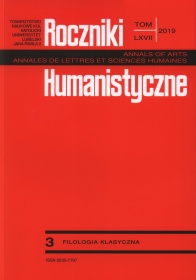Liczba podwójna w archaicznej poezji rzymskiej
Abstrakt
Epitafium Lucjusza Korneliusza Scypiona (syna Barbatusa), konsula z 259 roku p.n.e., zawiera starołacińską formę liczby podwójnej Tempestātēbus (dat. du.), odnoszącą się do dwóch bóstw pogody (CIL I2 9). Nazwa ta dowodzi istnienia w języku starołacińskim formacji dualnej *Tempestātē ‘dwa bóstwa pogody’. Wyraz aide, poświadczony w epitafium Scypiona, syna Barbatusa, może być zinterpretowany jako potencjalna forma liczby podwójnej: *aideē (nom.-acc. du. f.) ‘dwudzielna świątynia; budynek sakralny z dwoma sanktuariami’. Liwiusz Andronik używał kilku form liczby podwójnej w łacińskim przekładzie Odysei Homera, między innymi genū (nom.-acc. du. n.) ‘dwa kolana’ (fr. 14), inque manū (acc. du. f.) ‘i do obu rąk’ (fr. 5). Nie wiadomo jednak, czy w przekładzie Andronika użycie liczby podwójnej było konsekwentne, czy opcjonalne. Newiusz wprowadzał do epickiego dzieła Bellum Punicum formy dualne, np. hōc Samnītē ‘ci dwaj Samnici’ (fr. 36). Wydaje się jednak, że poeta nie czynił tego konsekwentnie. Analiza metryczna i rzeczowa niektórych zachowanych fragmentów nie daje jednoznacznej odpowiedzi, czy u Newiusza użycie form liczby dualnej było obligatoryjne, czy wynikało ze swobodnego wyboru rzymskiego poety. W niektórych fragmentach, przekazanych przez tradycję pośrednią, łatwo mogło dojść do sekundarnej pluralizacji dawnych form dualnych.
Bibliografia
Appel W., O nietypowym znaczeniu dualisu, „Meander” 38(1983), s. 319-327.
Appel W., Zagadka syren. Filologa peregrynacje od antyku do współczesności, Toruń: Wydawnictwo Naukowe Uniwersytetu Mikołaja Kopernika 2017.
Bernardi Perini G., Due problemi di fonetica latina: I. Muta cum liquida, II. S finale, Roma: Edizioni dell’Ateneo 1974.
Chantraine P., Grammaire homérique, t. II: Syntaxe, Paris: Librairie C. Klincksieck 1953.
Cn. Naevii Belli Punici carminis quae supersunt, red. W. Strzelecki, Lipsiae: B.G. Teubner 1964.
Cuny A., Le nombre duel en grec, Paris: Librairie C. Klincksieck 1906.
Fragmenta poetarum Latinorum epicorum et lyricorum praeter Ennium et Lucilium, red. Blänsdorf J., Stutgardiae et Lipsiae: B.G. Teubner 19953.
Giannini S., Un problema di fonosintassi del latino: la consonante -s finale, „Studi e saggi linguistici” 26(1986), s. 111-136.
Meillet A., L’emploi du duel chez Homère et l’élimination du duel, „Mémoires de la Société de Linguistique de Paris” 22(1922), s. 145-164.
Remains of Old Latin, vol. IV: Archaic Inscriptions, red. E.H. Warmington, London: William Heinemann Ltd.–Cambridge, MA: Harvard University Press 19593.
Richardson L., jr.: A New Topographical Dictionary of Ancient Rome, Baltimore–London: The Johns Hopkins University Press 1992.
Strzelecki W., Zarys metryki łacińskiej, w: Metryka grecka i łacińska, red. M. Dłuska, W. Strzelecki, Wrocław: Zakład Narodowy imienia Ossolińskich, Wydawnictwo PAN 1959, s. 72-139.
Viti C., Dual, w: Encyclopedia of Ancient Greek Language and Linguistics, t. I, red. G.K. Giannakis, Leiden–Boston: Brill 2014, s. 533-534.
Viti C., The Use of the Dual Number in Homeric Greek, w: Akten der XIII. Fachtagung der Indogermanischen Gesellschaft vom 21. bis 27. September 2008 in Salzburg, red. T. Krisch, T. Lindner, Wiesbaden: Reichert Verlag 2011, s. 599-604.
Witczak K.T., Pozostałości liczby podwójnej w języku łacińskim epoki archaicznej, „Roczniki Humanistyczne” 65(2017), z. 3, s. 37-58.
Copyright (c) 2019 Roczniki Humanistyczne

Utwór dostępny jest na licencji Creative Commons Uznanie autorstwa – Użycie niekomercyjne – Bez utworów zależnych 4.0 Międzynarodowe.





